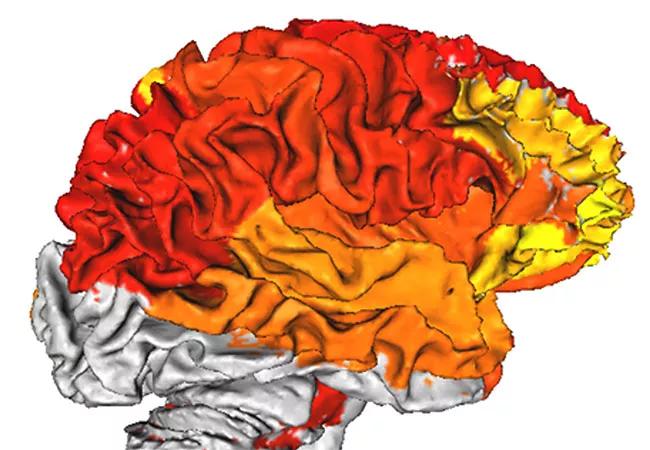Mechanistic insights in AD and a push for progress in CTE diagnosis

When a center operates one of the nation’s largest clinical trial programs for Alzheimer’s disease (AD) and other neurocognitive conditions, any given year is likely to yield notable research developments. For Cleveland Clinic Lou Ruvo Center for Brain Health, 2016 saw at least two such examples, recapped below.
Cleveland Clinic is a non-profit academic medical center. Advertising on our site helps support our mission. We do not endorse non-Cleveland Clinic products or services. Policy
Ever since reports that the cancer therapy bexarotene (Targretin) lowered brain amyloid-β, reduced plaque load and diminished behavioral deficits in mouse models of AD, interest in the agent has been keen.
That interest led to a phase 2a trial known as BEAT-AD, which was conducted at the Lou Ruvo Center for Brain Health among 20 patients aged 50 to 90 with AD confirmed by florbetapir scan. Patients were randomized in a double-blind fashion to four weeks of placebo or bexarotene 300 mg/day.
Results, published in Alzheimer’s Research & Therapy (2016;8:4), were mixed. The trial was negative for one of its primary outcome measures — namely, amyloid burden reduction (as assessed by florbetapir imaging) across the overall sample. But it showed that bexarotene significantly reduced amyloid burden in the subset of patients who were noncarriers of the ApoE4 allele for AD (Figure), which was also a primary prespecified outcome. In this same patient subset, brain amyloid reductions were correlated with increased serum amyloid-β1-42 measurements.

Figure. Images showing mean change in amyloid burden from baseline to week 4 among noncarriers of ApoE4 in the BEAT-AD trial’s bexarotene group (top) and placebo group (bottom). The red end of the color spectrum indicates reduced amyloid burden, whereas the blue end indicates increased amyloid burden.
While noting that the study was small and short, lead researcher Jeffrey Cummings, MD, ScD, says it’s the first time a small-molecule agent has been shown to lower amyloid in a subset of patients in a double-blind, placebo-controlled investigation.
“This biomarker-based proof-of-concept trial supports a mechanism-based biological effect of bexarotene on targets relevant to AD pathogenesis,” says Dr. Cummings, Director of the Lou Ruvo Center for Brain Health.
He and his center colleagues are now planning a longer phase 2/3 trial of bexarotene in both carriers and noncarriers of the ApoE4 allele who have mild to moderate AD. “Study of longer-duration treatment is warranted to see if there’s clinical benefit from bexarotene or other retinoid X receptor agonists,” notes Dr. Cummings.
In the meantime, he cautions against off-label use of bexarotene outside of a research setting, in view of potential cardiovascular risk from its tendency to raise serum triglyceride levels.
Despite the many headlines chronic traumatic encephalopathy (CTE) has attracted in recent years, the condition remains indisputably immature from a research standpoint, largely because CTE currently can be diagnosed only after death.
Now a major study launched in mid-2016 at several U.S. centers, including Lou Ruvo Center for Brain Health, aims to change that. DIAGNOSE CTE, funded by $16 million from the National Institute of Neurological Disorders and Stroke, is the largest study to date of living former athletes designed to provide insights for in vivo detection of CTE.
“The clinical presentation of CTE is still not well-characterized,” says Dr. Cummings, who is one of the trial’s four lead investigators. “There’s an urgent need to develop accurate methods for detecting and diagnosing CTE during life,” he adds, noting that much of the current understanding of CTE comes from its hallmark signs in the brains of deceased athletes who suffered repetitive head impacts over many years.
DIAGNOSE CTE will be seeking those methods by studying 240 men aged 45 to 74 with differing levels of exposure to repetitive head impacts (RHI):
Participants will be monitored for three years via neuroimaging studies (including PET for amyloid and tau biomarkers, diffusion tensor imaging and functional MRI, and MR spectroscopy), analysis of biofluids (blood, CSF and saliva), neurological examinations and neuropsychiatric tests.
The study’s use of an investigational PET tracer, AV-1451, is of particular interest. “We hypothesize that symptomatic participants with high or medium exposure to repeated head impacts will have elevated PET AV-1451 tau tracer uptake relative to controls and asymptomatic participants,” says Dr. Cummings. “We expect the profile of elevated AV-1451 uptake with normal florbetapir uptake to perhaps emerge as the gold-standard biomarker for CTE.”
Study objectives include characterizing the clinical presentation of CTE, examining longitudinal progression of CTE, refining and validating criteria for the clinical diagnosis of CTE, and investigating the genetic and head-impact risk factors for CTE.
“Our ultimate hope is to be able to detect CTE before brain damage occurs, even before symptoms start, and to discover means of preventing the disorder,” says Dr. Cummings.
He and his co-investigators expect to publish their first findings by late 2019 and final data in 2022.

Pilot study confirms feasibility of conducting additional research on the novel treatment

Longer hospitalization does not mean a safer, faster recovery for patients age 70+

Structured data helps identify older adults at risk for poor outcomes, defines patients who require more comprehensive assessments

Self-administered tool can be completed in 10 minutes in waiting room

Social prescribing turns leisure activities into good “medicine”

A large geriatric study aims to find the answers

Analysis underscores how telehealth can help pinpoint elder abuse